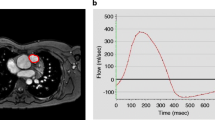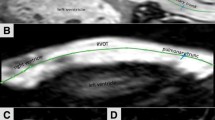Abstract
Objectives
To investigate the feasibility and accuracy of measurement of the pulmonary to systemic blood flow ratio (Qp/Qs) and defect and rim sizes in secundum atrial septal defects (ASDs) using 256-slice CT, compared to the reference transoesophageal echocardiography (TEE) and right heart catheterization (RHC) measurements.
Methods
Twenty-three consecutive adult patients with secundum ASDs who underwent retrospective ECG-gated coronary CT angiography (CCTA), TEE and RHC were enrolled in this study. Right ventricular (RV) and left ventricular (LV) stroke volumes (SV) were calculated by biventricular volumetry of CCTA. Qp/Qs-CT was defined as RVSV/LVSV. The sizes of the defect and rim were measured by multi-planar reconstruction CT images. Correlations between Qp/Qs-CT and Qp/Qs–RHC and between the defect diameter obtained by CT and TEE were analyzed by Pearson’s coefficient analysis. Rim sizes by CT and TEE were compared by paired t-test.
Results
Qp/Qs-CT was significantly correlated with Qp/Qs-RHC (r = 0.83, p < 0.0001), and the defect diameter by CT was significantly correlated with that by TEE (r = 0.95, p < 0.0001). There was no significant difference between CT and TEE in measurements of rim size.
Conclusions
256-slice CCTA allows measuring Qp/Qs and size of defects and rims in patients with secundum ASDs, accomplishing pretreatment evaluation non-invasively and comprehensively.
Key Points
• Quantification of left-to-right shunting can be performed reliably and accurately by CT.
• The sizes of defects and rims can be measured accurately using 256-slice CT.
• 256-slice CT permits pretreatment evaluation of ASD non-invasively and comprehensively.






Similar content being viewed by others
References
Hoffman JI, Kaplan S, Liberthson RR (2004) Prevalence of congenital heart disease. Am Heart J 147:425–439
Du ZD, Hijazi ZM, Kleinman CS, Silverman NH, Larnitz K, Investigators A (2002) Comparison between transcatheter and surgical closure of secundum atrial septal defect in children and adults - Results of a multicenter nonrandomized trial. J Am Coll Cardiol 39:1836–1844
Sugeng L, Mor-Avi V, Weinert L et al (2010) Multimodality comparison of quantitative volumetric analysis of the right ventricle. JACC Cardiovasc Imaging 3:10–18
Yamasaki Y, Nagao M, Yamamura K et al (2014) Quantitative assessment of right ventricular function and pulmonary regurgitation in surgically repaired tetralogy of Fallot using 256-slice CT: comparison with 3-Tesla MRI. Eur Radiol. doi:10.1007/s00330-014-3344-1
Goo HW, Park IS, Ko JK et al (2003) CT of congenital heart disease: Normal anatomy and typical pathologic conditions. Radiographics 23:S147–S165
Lee T, Tsai IC, Fu YC et al (2006) Using multidetector-row CT in neonates with complex congenital heart disease to replace diagnostic cardiac catheterization for anatomical investigation: initial experiences in technical and clinical feasibility. Pediatr Radiol 36:1273–1282
Eom HJ, Yang DH, Kang JW et al (2015) Preoperative cardiac computed tomography for demonstration of congenital cardiac septal defect in adults. Eur Radiol 25:1614–1622
Jensen CJ, Jochims M, Hunold P et al (2010) Assessment of left ventricular function and mass in dual-source computed tomography coronary angiography: influence of beta-blockers on left ventricular function: comparison to magnetic resonance imaging. Eur J Radiol 74:484–491
Malach M (1996) Cardiac catheterization, angiography, and intervention, 5th edition - Baim, DS, Grossman, W. J Community Health 21:466–467
Kondo M, Nagao M, Yonezawa M et al (2014) Improvement of Automated Right Ventricular Segmentation Using Dual-bolus Contrast Media Injection with 256-slice Coronary CT Angiography. Acad Radiol 21:648–653
Kerl JM, Ravenel JG, Nguyen SA et al (2008) Right heart: split-bolus injection of diluted contrast medium for visualization at coronary CT angiography. Radiology 247:356–364
Tobis J, Shenoda M (2012) Percutaneous Treatment of Patent Foramen Ovale and Atrial Septal Defects. J Am Coll Cardiol 60:1722–1732
Durongpisitkul K, Tang NL, Soongswang J, Laohaprasitiporn D, Nanal A (2004) Predictors of successful transcatheter closure of atrial septal defect by cardiac magnetic resonance imaging. Pediatr Cardiol 25:124–130
Earls JP, Berman EL, Urban BA et al (2008) Prospectively gated transverse coronary CT angiography versus retrospectively gated helical technique: improved image quality and reduced radiation dose. Radiology 246:742–753
Hausleiter J, Meyer T, Hadamitzky M et al (2006) Radiation dose estimates from cardiac multislice computed tomography in daily practice - Impact of different scanning protocols on effective dose estimates. Circulation 113:1305–1310
Maruyama T, Takada M, Hasuike T, Yoshikawa A, Namimatsu E, Yoshizumi T (2008) Radiation Dose Reduction and Coronary Assessability of Prospective Electrocardiogram-Gated Computed Tomography Coronary Angiography Comparison With Retrospective Electrocardiogram-Gated Helical Scan. J Am Coll Cardiol 52:1450–1455
Oda S, Utsunomiya D, Funama Y et al (2011) A low tube voltage technique reduces the radiation dose at retrospective ECG-gated cardiac computed tomography for anatomical and functional analyses. Acad Radiol 18:991–999
Nguyen PK, Lee WH, Li YF et al (2015) Assessment of the Radiation Effects of Cardiac CT Angiography Using Protein and Genetic Biomarkers. JACC Cardiovasc Imaging 8:873–884
Acknowledgements
The scientific guarantor of this publication is Hiroshi Honda. The authors of this manuscript declare relationships with the following companies: Nagao M. and Kawanami S: Bayer Healthcare Japan, Modest, Research Grant; Philips Electronics Japan, Modest, Research Grant
This study has received funding from the Japan Society for the Promotion of Science (JSPS) KAKENHI (25461831). No complex statistical methods were necessary for this paper.
Institutional Review Board approval was obtained. Written informed consent was obtained from all subjects (patients) in this study. Methodology: prospective, diagnostic study, performed at one institution.
Author information
Authors and Affiliations
Corresponding author
Rights and permissions
About this article
Cite this article
Yamasaki, Y., Nagao, M., Kawanami, S. et al. One-stop shop assessment for atrial septal defect closure using 256-slice coronary CT angiography. Eur Radiol 27, 697–704 (2017). https://doi.org/10.1007/s00330-016-4407-2
Received:
Revised:
Accepted:
Published:
Issue Date:
DOI: https://doi.org/10.1007/s00330-016-4407-2




